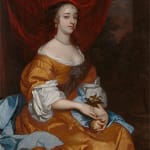

Studio of Sir Peter Lely
Portrait of Margaret Hughes (d. 1719), late 1660s
Oil on canvas
49 x 40 ¼ in (120.5 x 102.3 cm)
Philip Mould & Co.
To view all current artworks for sale visit philipmould.com This picture is a high-quality contemporary studio replica of an original portrait by Lely now held in the Johnson Museum of...
To view all current artworks for sale visit philipmould.com
Little is known of the origins of Margaret Hughes. She may well have been among the first group of actresses to have joined the King’s Company following the relaxation of morals and subsequent boom in the theatrical profession that followed the Restoration. A later commentator cites her career as having begun at the Theatre Royal, Drury Lane as early as 1663. During these years, she is recorded as having performed the role of Desdemona in Shakespeare’s Othello – the first woman documented as having acted the part. By the late 1660s, she had become established as a leading actress and debuted roles written by Dryden among others. When in 1668 Samuel Pepys caught a fleeting kiss from a ‘mighty pretty’ actress who was performing in the racily-titled Virgin Martyr, it may well have been from Margaret Hughes.
Pepys’s comment that, despite the actress’s beauty, she was ‘not, [sic] modest’ chimes well with what is known about her personality. Spotted and introduced to court in the year that Pepys may have met her, Margaret was possessed of all the guile that was required to make a successful court debut. Confident and aware of the power that her good looks held in a court that was populated by philandering men, Margaret saw little to be gained from being demure. One revealing anecdote, which although it was written many years after the event was said to have taken place reveals much about how contemporaries saw Margaret’s personality, describes her first encounter with Prince Rupert. Although he had been one of the heroes of the royalist cause during the English Civil War, Rupert, it would seem, was at a loss when it came to convincing the opposite sex of his charms. To the hilarity of all at court – including Charles II, Rupert’s cousin – he ineptly tried to woo Margaret by offering her large sums of money. Unimpressed, Margaret brazenly asked for more. Not used to having his affections spurned, Rupert’s courtship increased in desperation to the point that he became quite unrecognisable to observers.
Regardless of the veracity of this anecdote, Rupert eventually succeeded in wooing Margaret, who became his mistress. Rupert’s affections for Margaret were strong, to the point that he made her is sole mistress – an accolade that was rare in the Restoration court. Margaret quickly became one of the most popular beauties of the court, second only to Nell Gwynn. This was a matter of not inconsiderable importance in the world of the Restoration. In 1670 the question of which was the greater mistress, Gwynn or Hughes, provoked two servants – one of Charles II and the other of Rupert – to a heated argument. The argument was settled when Rupert’s man, also called Hughes, was run through and killed by the sword of his opponent.
With the birth of Margaret’s daughter, Ruperta, in 1673, Margaret and Rupert began to lead a life that was ever more domesticated. This was to the considerable alarm of many members of Rupert’s family. In 1674, his sister Sophia wrote of her fear that Margaret would inherit the crown jewels of the “Winter Queen”, Elizabeth of Bohemia. In 1679, she had still yet to be persuaded of Margaret’s appeal. When informed by a Danish ambassador that Margaret was the most virtuous of English women, Sophia acidly retorted that to say that was no great praise.
In 1676 Margaret performed again on the stage as a member of the Duke of York’s Company, but it was to be her last season. The following year, she retired from treading the boards to devote herself both to her daughter and to Rupert, whose health was by now ailing. Yet, despite Rupert’s poor health, life at home was happy. In 1682, Rupert wrote to his sister Sophia of the progress of his daughter, writing with the amusement of a loving father of Ruperta’s rule over the house. When he died that same year, Rupert made Margaret the chief beneficiary of his will, leaving his mistress with a small fortune’s worth of land, jewels, and works of art. A deathbed request to Charles II for Ruperta to be married to his son by Nell Gwynn was, however, refused; another victory for the latter in the war of the court beauties. She was eventually to marry Brigadier-General Rupert Scrope Howe, brother of the first Viscount Howe, whose ardent support of the Glorious Revolution that deposed Charles’s brother perhaps allowed Margaret to have the last laugh. A satirical remark refers to Margaret’s gambling away of the fortune that she was left by Rupert. However, like much that was said about Margaret, the accuracy of the statement remains a mystery. She died in 1712 in Eltham, Kent.
Provenance
Private Collection, New Jersey, USA
Be the first to hear about our available artworks
* denotes required fields
We will process the personal data you have supplied in accordance with our privacy policy (available on request). You can unsubscribe or change your preferences at any time by clicking the link in our emails.

